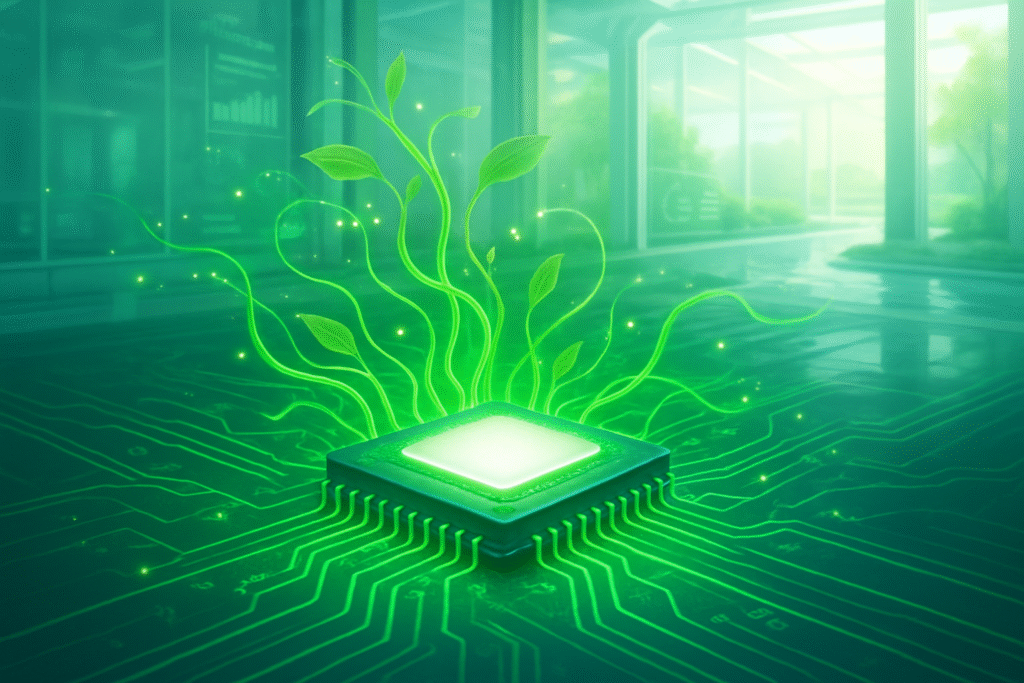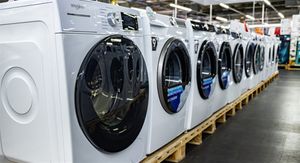
The global semiconductor industry, the foundational engine of our increasingly digital and AI-driven world, is undergoing a profound and necessary transformation. Faced with escalating environmental concerns, stringent regulatory pressures, and growing demands for corporate responsibility, manufacturers are now placing an unprecedented focus on sustainability and energy efficiency. This critical shift aims to significantly reduce the industry's substantial environmental footprint, which historically has been characterized by immense energy and water consumption, the use of hazardous chemicals, and considerable greenhouse gas emissions. As the demand for advanced chips continues to surge, particularly from the burgeoning artificial intelligence sector, the imperative to produce these vital components in an eco-conscious manner has become a defining challenge and a strategic priority for the entire tech ecosystem.
This paradigm shift, often dubbed the "Green IC Industry," is driven by the recognition that the environmental costs of chip production are no longer externalities but core business considerations. With projections indicating a near-doubling of semiconductor revenue to $1 trillion globally by 2030, the industry's ecological impact is set to grow exponentially if traditional practices persist. Consequently, companies are setting ambitious net-zero targets, investing heavily in green technologies, and exploring innovative manufacturing processes to ensure that the very building blocks of our technological future are forged with planetary stewardship in mind.
Engineering a Greener Silicon Valley: Technical Innovations in Sustainable Chip Production
The push for sustainable semiconductor manufacturing is manifesting in a wave of technical innovations across the entire production lifecycle, fundamentally altering how chips are made. These advancements represent a significant departure from previous, more resource-intensive approaches, focusing on minimizing environmental impact at every stage. Key areas of development include radical improvements in water management, a pivot towards green chemistry, comprehensive energy optimization, and the exploration of novel, eco-friendly materials.
Water conservation stands as a critical pillar of this transformation. Semiconductor fabrication, particularly the extensive use of ultrapure water (UPW) for cleaning, consumes millions of liters daily in a single large fab. To counter this, manufacturers are deploying advanced closed-loop water recycling systems that treat and reintroduce wastewater back into production, significantly reducing fresh water intake. This contrasts sharply with older linear models of water usage. Furthermore, efforts are underway to optimize UPW generation, increase recovery rates from municipal sources, and even replace water-intensive wet processes with dry alternatives, directly cutting consumption at the source.
In the realm of chemical usage, the industry is embracing "green chemistry" principles to move away from hundreds of hazardous chemicals. This involves substituting high global warming potential substances like perfluorinated chemicals (PFCs) with safer alternatives, optimizing process techniques for precision dosing to minimize waste, and deploying advanced gas abatement technologies to detoxify emissions before release. Innovations such as dry plasma cleaning are replacing corrosive acid washes, demonstrating a direct shift from hazardous, environmentally damaging methods to cleaner, more efficient ones. Additionally, chemical recycling processes are being developed to recover and reuse valuable materials, further reducing the need for virgin chemicals.
Energy consumption optimization is another crucial focus, given that fabs are among the most energy-intensive sites globally. Manufacturers are aggressively integrating renewable energy sources, with leaders like TSMC (Taiwan Semiconductor Manufacturing Company) (TWSE: 2330) and Intel (NASDAQ: INTC) committing to 100% renewable electricity. Beyond sourcing, there's a strong emphasis on waste heat recovery, energy-efficient chip design (e.g., low-power techniques and smaller process nodes), and equipment optimization through idle-time controllers and smart motor drive control schemes. Crucially, AI and Machine Learning are playing an increasingly vital role, enabling precise control over manufacturing processes, optimizing resource usage, and predicting maintenance needs to reduce waste and energy consumption, representing a significant technical leap from manual or less sophisticated control systems.
The Green Imperative: Reshaping Competition and Strategy in the AI Era
The escalating focus on sustainability and energy efficiency in semiconductor manufacturing is not merely an operational adjustment; it is a profound strategic force reshaping the competitive landscape for AI companies, tech giants, and innovative startups. As the foundational technology for all digital advancements, the "green" evolution of chips carries immense implications for market positioning, product development, and supply chain resilience across the entire tech spectrum.
Major tech giants, driven by ambitious net-zero commitments and increasing pressure from consumers and investors, are at the forefront of this shift. Companies like Apple (NASDAQ: AAPL), Microsoft (NASDAQ: MSFT), Amazon (NASDAQ: AMZN), and Alphabet (NASDAQ: GOOGL) are leveraging their immense purchasing power to demand greener practices from their semiconductor suppliers. This translates into a competitive advantage for manufacturers like TSMC (Taiwan Semiconductor Manufacturing Company) (TWSE: 2330), Intel (NASDAQ: INTC), and Samsung (KRX: 005930), who are aggressively investing in renewable energy, water conservation, and waste reduction. Furthermore, these tech giants are increasingly investing in custom silicon, allowing them to optimize chips not just for performance but also for energy efficiency, gaining strategic control over their environmental footprint and supply chain.
For AI companies, the implications are particularly acute. The exponential growth of AI models, from large language models to advanced machine learning applications, demands ever-increasing computational power. This, in turn, fuels a massive surge in energy consumption within data centers, which are the backbone of AI operations. Therefore, the availability of energy-efficient chips is paramount for AI companies seeking to mitigate their own environmental burden and achieve sustainable growth. Companies like NVIDIA (NASDAQ: NVDA), while a leader in AI hardware, must work closely with their foundry partners to ensure their cutting-edge GPUs are manufactured using the greenest possible processes. The development of new, low-power chip architectures, especially for edge AI devices, also presents opportunities for disruption and new market entries.
Startups, while facing higher barriers to entry in the capital-intensive semiconductor industry, are finding fertile ground for innovation in niche areas. Agile climate tech startups are developing solutions for advanced cooling technologies, sustainable materials, chemical recovery, and AI-driven energy management within semiconductor fabs. Initiatives like "Startups for Sustainable Semiconductors (S3)" are connecting these innovators with industry leaders, indicating a collaborative effort to scale green technologies. These startups have the potential to disrupt existing products and services by offering more sustainable alternatives for production processes or eco-friendly materials. Ultimately, companies that successfully integrate sustainability into their core strategy—from chip design to manufacturing—will not only enhance their brand reputation and attract talent but also achieve significant cost savings through improved operational efficiency, securing a crucial competitive edge in the evolving tech landscape.
Beyond the Fab: Sustainability's Broad Reach Across AI and Society
The escalating focus on sustainability and energy efficiency in semiconductor manufacturing transcends mere industrial refinement; it represents a fundamental shift in technological responsibility with profound implications for the broader AI landscape and society at large. This movement acknowledges that the relentless pursuit of digital advancement must be intrinsically linked with environmental stewardship, recognizing the dual nature of AI itself in both contributing to and potentially solving ecological challenges.
At its core, this shift addresses the immense environmental footprint of the semiconductor industry. Chip fabrication is a resource-intensive process, consuming vast quantities of energy, water, and chemicals, and generating significant greenhouse gas emissions. Without this concerted effort towards greener production, the industry's contribution to global CO2 emissions could become unsustainable, particularly as the demand for AI-specific hardware surges. The emphasis on renewable energy, advanced water recycling, green chemistry, and circular economy principles is a direct response to these pressures, aiming to mitigate climate change, conserve vital resources, and reduce hazardous waste. This paradigm shift signals a maturation of the tech industry, where environmental and social costs are now integral to progress, moving beyond the sole pursuit of performance and speed that characterized earlier technological milestones.
The integration of this sustainable manufacturing drive within the broader AI landscape is particularly critical. AI's insatiable demand for computational power fuels the need for increasingly sophisticated, yet energy-efficient, semiconductors. The exponential growth of AI models, from large language models to generative AI, translates into massive energy consumption in data centers. Therefore, developing "green chips" is not just about reducing the factory's footprint, but also about enabling a truly sustainable AI ecosystem where complex models can operate with a minimal carbon footprint. AI itself plays a pivotal role in this, as AI and Machine Learning algorithms are being deployed to optimize fab operations, manage resources in real-time, predict maintenance needs, and even accelerate the discovery of new sustainable materials, showcasing AI's potential as a powerful tool for environmental solutions.
However, this transformative period is not without its concerns. The sheer energy consumption of AI remains a significant challenge, with data centers projected to account for a substantial percentage of global electricity consumption by 2030. Water usage for cooling these facilities also strains municipal supplies, and the rapid obsolescence of AI hardware contributes to growing e-waste. Moreover, the high initial costs of transitioning to greener manufacturing processes and the lack of globally harmonized sustainability standards present significant hurdles. Despite these challenges, the current trajectory signifies a crucial evolution in the tech industry's role in society, where the pursuit of innovation is increasingly intertwined with the imperative of planetary stewardship, marking a new era where technological progress and environmental responsibility are mutually reinforcing goals.
The Road Ahead: Innovations and Challenges in Sustainable Semiconductor Manufacturing
The trajectory of sustainability and energy efficiency in semiconductor manufacturing points towards a future defined by radical innovation, deeper integration of circular economy principles, and pervasive AI integration. While the journey is complex, experts anticipate an acceleration of current trends and the emergence of groundbreaking technologies to meet the dual demands of exponential chip growth and environmental responsibility.
In the near term (the next 1-5 years), expect to see widespread adoption of renewable energy sources becoming standard for leading fabrication plants, driven by aggressive net-zero targets. Advanced closed-loop water reclamation systems will become commonplace, with some facilities pushing towards "net positive" water use. There will also be a rapid acceleration in the implementation of green chemistry practices, substituting hazardous chemicals with safer alternatives and optimizing processes to reduce chemical consumption. Furthermore, AI and Machine Learning will become indispensable tools, optimizing fab operations, managing resources, and enabling predictive maintenance, potentially cutting a fab's carbon emissions by around 15%. This continued integration of AI will be crucial for real-time process control and efficiency gains.
Looking further ahead (beyond 5 years), the vision of a fully circular economy for semiconductors will begin to materialize, where materials are continuously reused and recycled, drastically reducing waste and reliance on virgin raw materials. Novel materials like Gallium Nitride (GaN) and Silicon Carbide (SiC) will become standard in power electronics due to their superior efficiency, and research into carbon-based nanomaterials like graphene will unlock new possibilities for energy-efficient chip architectures. The U.S. Department of Commerce is even investing $100 million to leverage AI for autonomous experimentation in developing new, sustainable semiconductor materials, aiming for adoption within five years. Energy recovery technologies, capturing and reusing waste heat, and potentially exploring clean energy sources like advanced nuclear power, are also on the horizon to meet the immense, clean energy demands of future fabs, especially for AI-driven data centers.
Despite this promising outlook, significant challenges remain. The inherently high energy consumption of advanced node manufacturing, coupled with the projected surge in demand for AI chips, means that mitigating carbon emissions will be a continuous uphill battle. Water scarcity, particularly in regions hosting major fabs, will continue to be a critical concern, necessitating even more sophisticated water recycling and reuse technologies. The complex global supply chain also presents a formidable challenge in managing Scope 3 emissions. Experts predict that while emissions from the industry will continue to grow in the short term due to escalating demand for advanced technologies, the long-term outlook emphasizes strategic roadmaps and deep collaboration across the entire ecosystem—from R&D to end-of-life planning—to fundamentally reshape how chips are made. The ability of the industry to overcome these hurdles will ultimately determine the sustainability of our increasingly AI-powered world.
Forging a Sustainable Future: The Enduring Impact of Green Chips
The semiconductor industry's intensifying focus on sustainability and energy efficiency marks a pivotal moment in the history of technology. What was once a secondary consideration has now become a core strategic imperative, driving innovation and reshaping the entire tech ecosystem. This journey towards "green chips" is a testament to the industry's evolving responsibility, acknowledging that the foundational components of our digital world must be produced with meticulous attention to their environmental footprint.
Key takeaways underscore a holistic approach to sustainability: aggressive adoption of renewable energy sources, groundbreaking advancements in water reclamation and reuse, a decisive shift towards green chemistry, and relentless pursuit of energy-efficient chip designs and manufacturing processes. Crucially, artificial intelligence itself emerges as both a significant driver of increased energy demand and an indispensable tool for achieving sustainability goals within the fab. AI and Machine Learning are optimizing every facet of chip production, from resource management to predictive maintenance, demonstrating their transformative potential in reducing environmental impact.
The significance of this development for AI history and the broader tech industry cannot be overstated. A truly sustainable AI future hinges on the availability of energy-efficient chips, mitigating the environmental burden of rapidly expanding AI models and data centers. For tech giants, embracing sustainable manufacturing is no longer optional but a competitive differentiator, influencing supply chain decisions and brand reputation. For innovative startups, it opens new avenues for disruption in eco-friendly materials and processes. The long-term impact promises a redefined tech landscape where environmental responsibility is intrinsically linked to innovation, fostering a more resilient and ethically conscious digital economy.
In the coming weeks and months, watch for continued aggressive commitments from leading semiconductor manufacturers regarding renewable energy integration and net-zero targets. Keep an eye on government initiatives, such as the CHIPS for America program, which will continue to fund research into sustainable semiconductor materials and processes. Innovations in advanced cooling technologies, particularly for data centers and AI accelerators, will be critical. Furthermore, the increasing focus on Scope 3 emissions across complex supply chains and the development of circular economy practices, driven by new regulations, will be key indicators of the industry's progress. The path to truly sustainable semiconductor manufacturing is challenging, but the collective momentum and strategic importance of "green chips" signify a profound and enduring commitment to forging a more responsible technological future.
This content is intended for informational purposes only and represents analysis of current AI developments.
TokenRing AI delivers enterprise-grade solutions for multi-agent AI workflow orchestration, AI-powered development tools, and seamless remote collaboration platforms.
For more information, visit https://www.tokenring.ai/.






